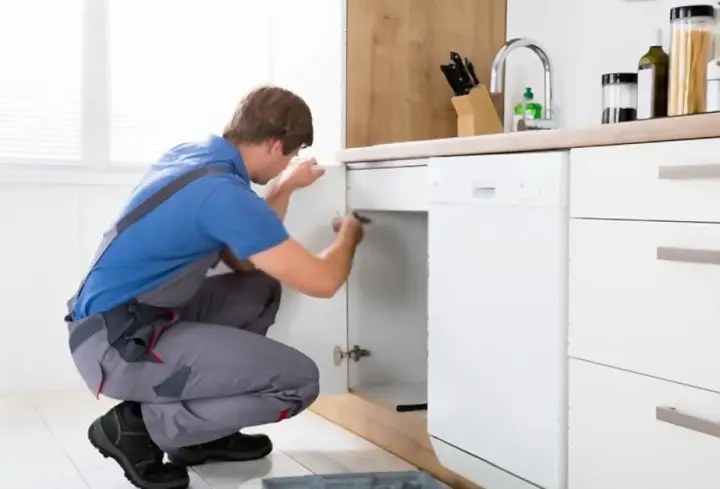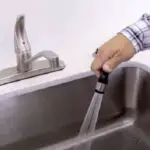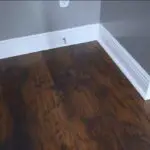When you plan to renovate the kitchen, you always came across a fundamental problem. You love the beautiful granite countertop, but the kitchen cabinet underneath it seems to be worn out or outdated for the time.
Thus, many people actually want to replace the kitchen cabinet but not the countertop, especially when running on a tight budget. But can you replace kitchen cabinets without replacing the countertop? What expert plumbers have to say?
Yes, you have a piece of good news. You can replace the kitchen cabinets without removing the countertop. You have to get the newer cabinets from the hardware shops and remove the older cabinet underneath the countertop carefully. Then, you can replace the older cabinet. Also, use studs to support the countertop in the meantime.
Can You Replace Kitchen Cabinets Without Replacing Countertop?
Yes, you can replace the kitchen cabinet without hurting the countertop. Also, the process is easier than most people actually think. On top of it, the DIY kitchen cabinet replacement saves you from paying a huge sum to professional plumbers or woodworkers.
You have to be careful at providing enough support to the stone or wooden countertop before you can remove the base cupboards and the cabinet frame. Since the countertop is a heavyweight construction, you have to provide it enough support so it can stand out from the replacement task.
You should use studs to properly support the countertop so that it doesn’t fall off from the top to damage the entire cabinet setup. We will use 2X4 studs for this purpose.
How to Remove Kitchen Cabinets Without Removing Countertop?
You should now thoroughly understand that. It is possible to remove the old kitchen cabinet with a newer one without removing the countertop. But the question is, how do you remove the cabinets without damaging the kitchen countertop?
While many plumbers would suggest many a thing, the best way to do it is to change the cabinet. You won’t have to think too much of the technical issues on it.
Step 1: Loosening the Cabinet Installation Screws
When you observe the interior of the kitchen cabinet, you will find several screws attaching to the cabinet and the adjacent walls. These screws securely hold the cabinet of the kitchen against the walls. You must remove the screws one by one to prepare the cabinet for removal.
You have to consider two preconditions for the purpose-
- Whether the cabinet was installed before the flooring or not? You may not be able to remove the cabinet completely in this case as it is attached to the kitchen floor.
- Also, consider how the toe base was constructed. At times, the toe base doesn’t have a separate workpiece. Instead, it is built with the cabinet directly. In this case, you can’t remove the cabinet without damaging it. You have to destroy the cabinet boxes to replace them with new ones.
Step 2: Cutting the Plumbing Area Sides
At most times, the backside of the cabinet will be attached to the plumbing area. It might give you a hard time removing the cabinetry from the underneath of its countertop. You have to ensure that you don’t damage the plumbing set up in this process.
You might use a salzsaw or saber saw for the purpose. Use the saw that you are comfortable working with to ensure a better result. Once you have got your favorite saw, use it to cut around the kitchen plumbing areas close to the cabinet.
When you cut around the plumbing areas, make sure the cuts are large enough. It must accommodate the cabinet so it can slide past the kitchen sink. Also, don’t hurry to cut through the areas, or you will run the risk of damaging the plumbing setup.
An alternative cutting technique:
Many people find the use of the salzsaw or saber saw difficult. Thus, you might consider using an alternative yet practically effective cutting technique. You can use it to cut the backside of the kitchen cabinet from the adjacent plumbing areas.
You should tap the cabinet walls with optimal forces to knock them out of the installment spot. Once you knock out the back of the cabinet, try removing these walls one by one. Be careful not to hurt the plumbing setup.
Step 3: Using the Studs for Countertop Support
We have already mentioned that the kitchen countertop, particularly the granite and stone countertops, are heavyweight. Thus, it lacks proper support; it might fall off from the top and damage the entire cabinet installation.
We use 2”X4” studs for this purpose. Also, the studs should be sturdy enough to support the heavy countertop. As you remove one side of the cupboard, mount the stud, so it holds the countertop properly. Follow the same stud mounting technique for all the sides so that the countertop remains in good condition.
Step 4: Inspecting the Cabinet Walls
As the cabinet wall is placed close to the plumbing system, often, these walls become damp. It triggers the growth of mold and mildew. It can be detrimental to the newly installed kitchen cabinet and its walls. Also, mold growth isn’t good for your health.
Thus, observe the walls around the cabinet and the plumbing system. If you find any mold development, you should use a commercial mold killer to remove the mold and mildews. Also, use dampen removers on the walls so that it remains dry. Thus, it will protect the walls from getting damp in the future.
If the mold is too much and the walls are damaged too much, you may consider taking help from professional contractors. Also, inspect the plumbing areas and see whether or not it has any leaks. If you found any leaks, use Teflon tape to seal them accurately.
Step 5: Install the New Cabinet
After you are satisfied that the walls aren’t damped anymore, you can mount the new kitchen cabinet. You have to push the cabinet walls against the previously cut sides near the plumbing areas. Once the cabinet is placed carefully, you can remove the supporting studs underneath the countertop.
Then tighten the screws one by one, and finally, check if there is any gap in the plumbing areas. You have to fill it up with the right material, such as concrete or Teflon, for durability.
Can You Replace Countertops Without Damaging Cabinets?
While most kitchen renovations are concerned with cabinet removal, some people want to replace the countertop too. The good news is that you can replace the granite or stone countertop easily without hurting the cabinets.
If the countertop has stains or starts eroding, you should consider replacing it with a new one. However, you have to be strictly careful to remove or replace the granite countertop as it is weighty and extremely solid. We recommend you call the professionals to complete the job for you. It may be a bit expensive, but you will save yourself from damaging the cabinet and hurting yourself.
Conclusion
So, can you replace kitchen cabinets without replacing the countertop? Ideally speaking, it is an easy and convenient process to remove the kitchen cabinet by providing studs as the countertop support. The key is to remain patient and work step by step with care and precautions. Once you follow our suggestions on the kitchen cabinet removal process, you should find it easier than you previously thought about it.



